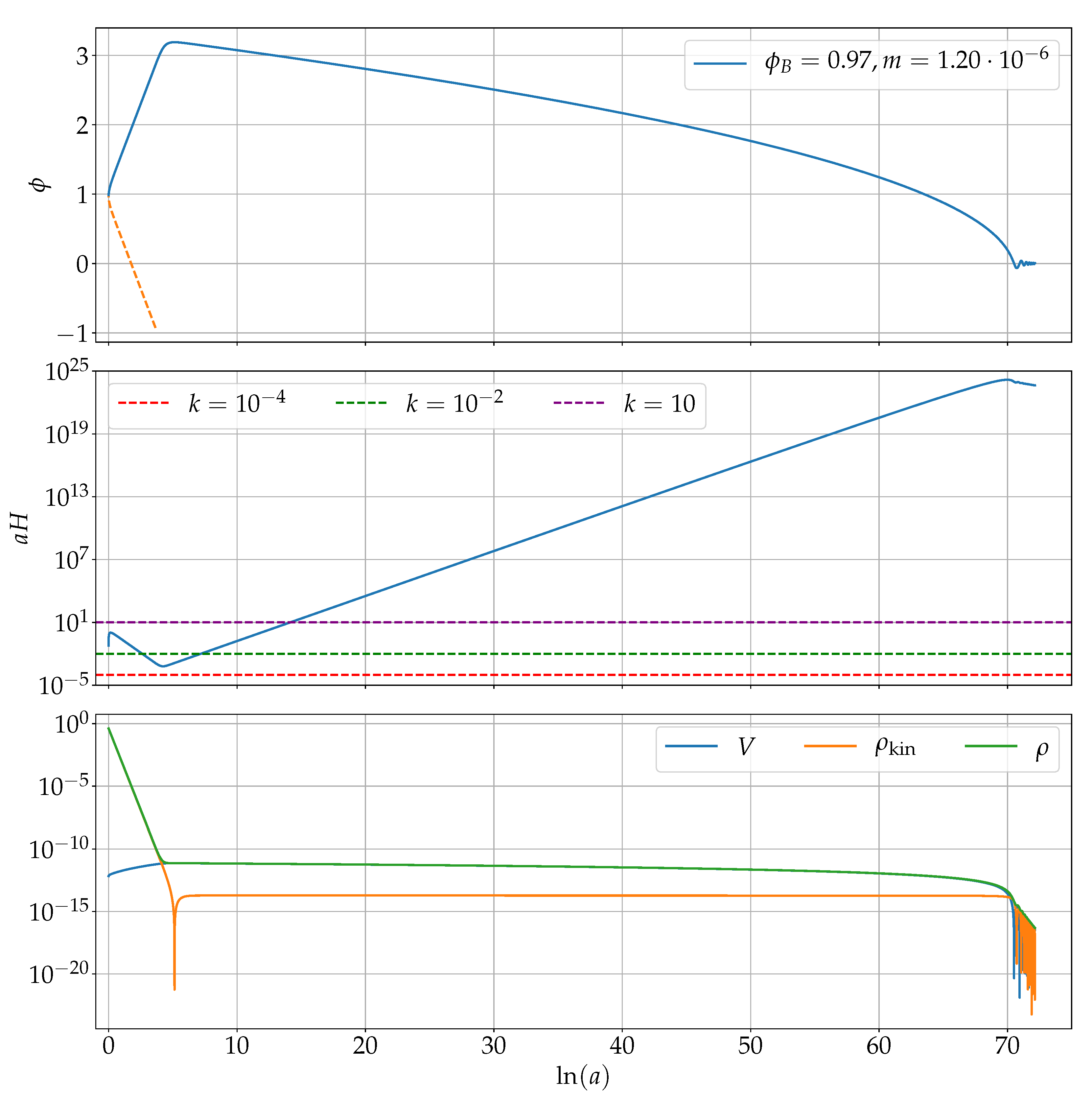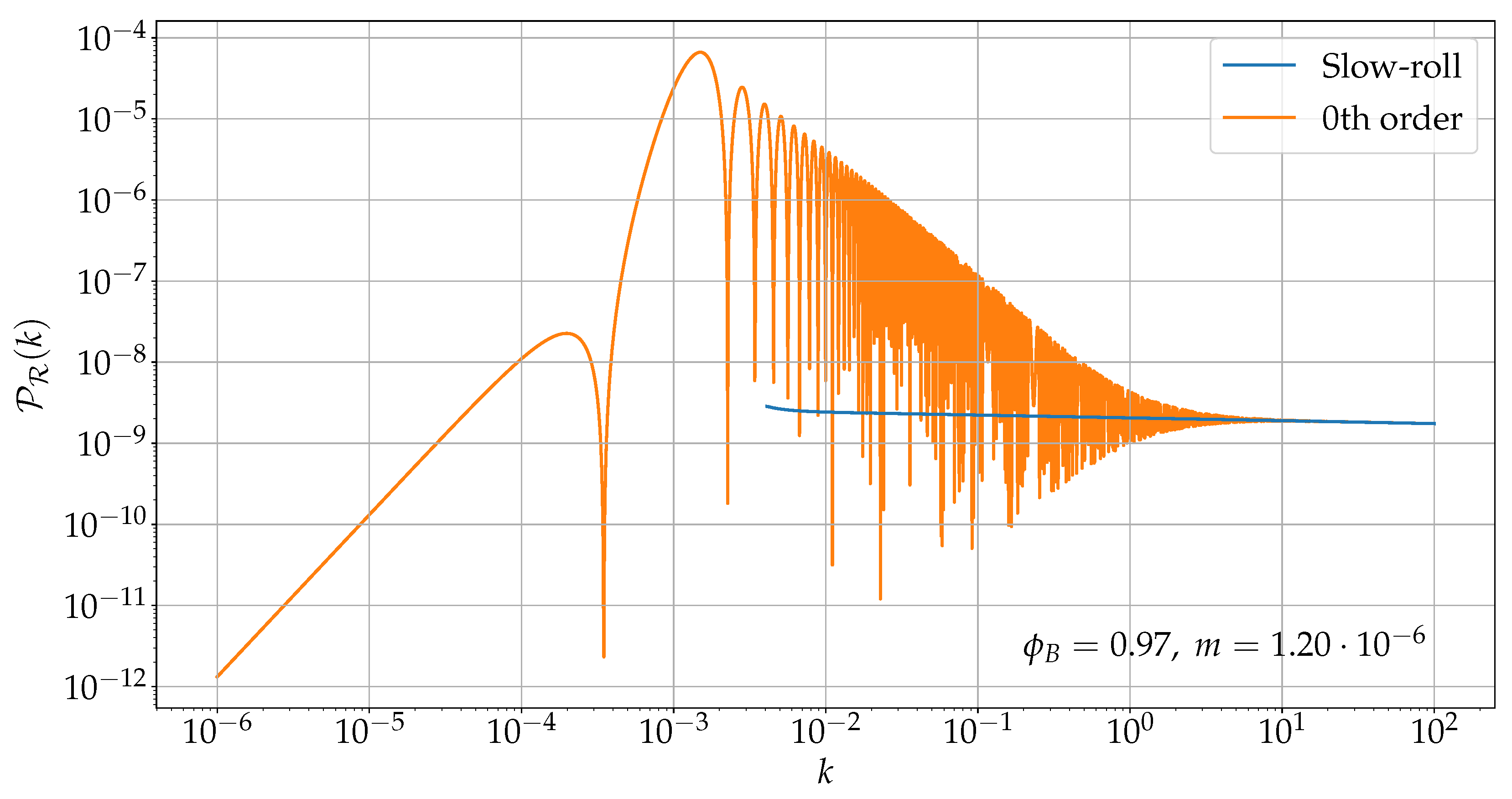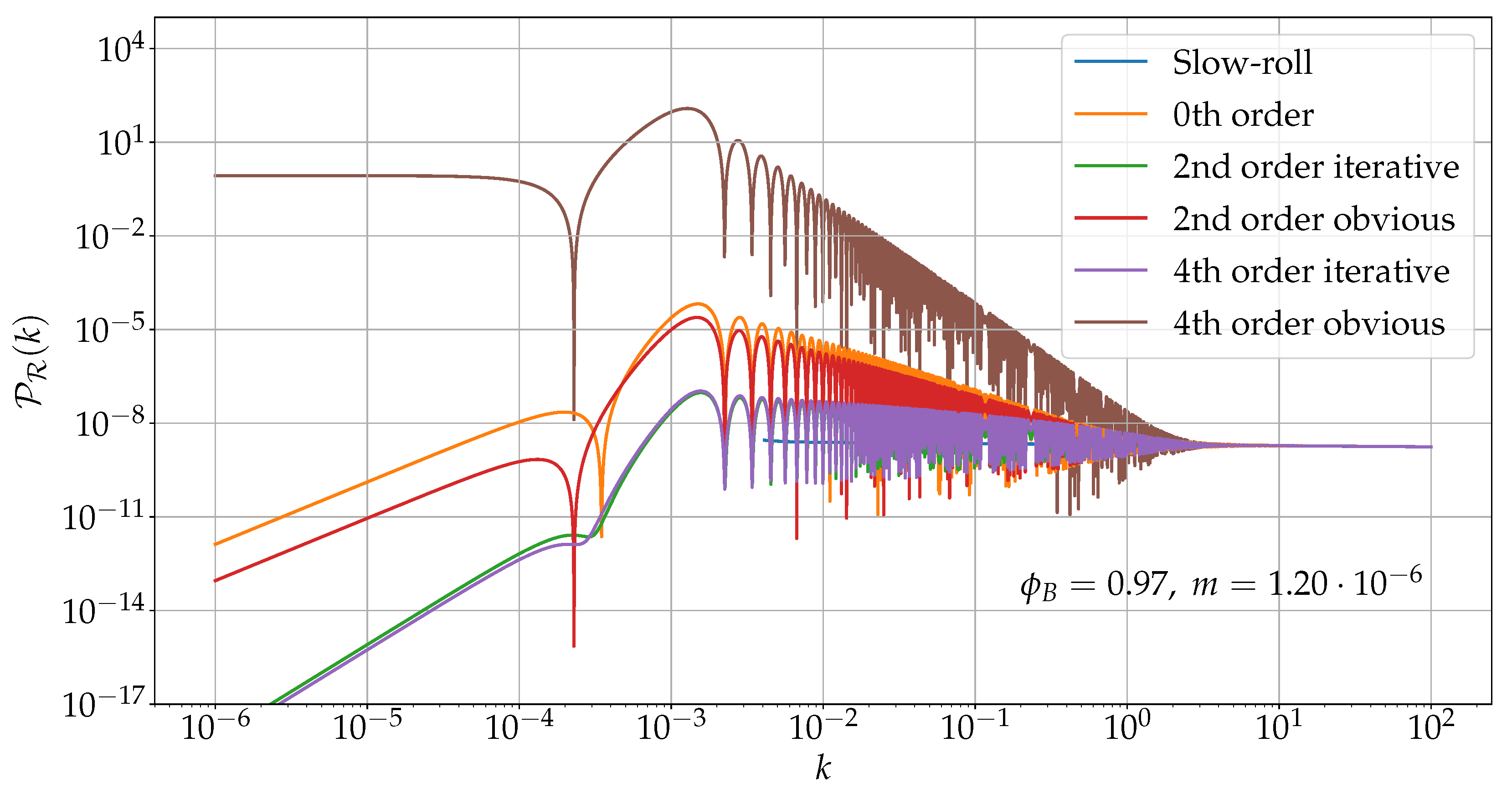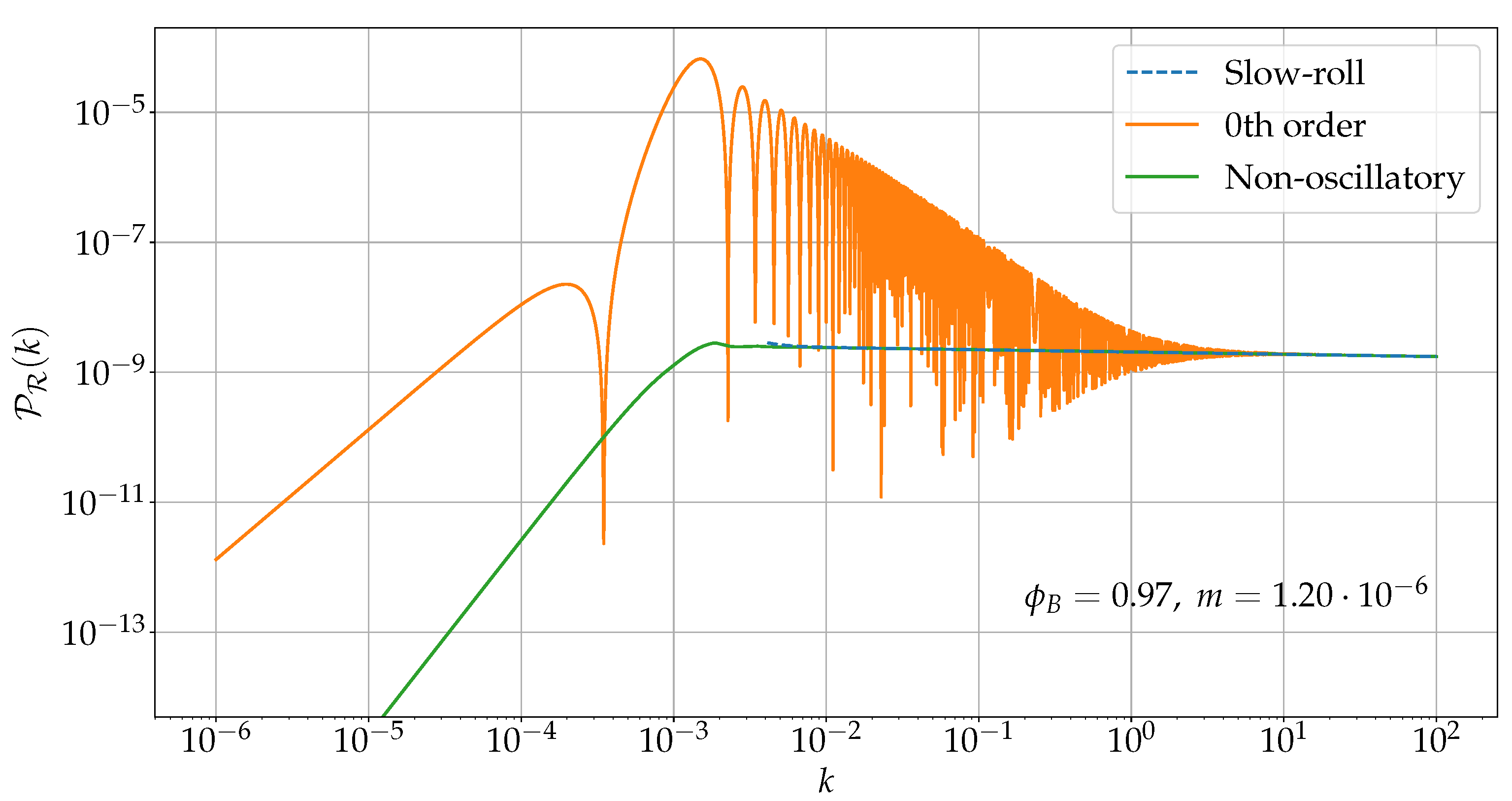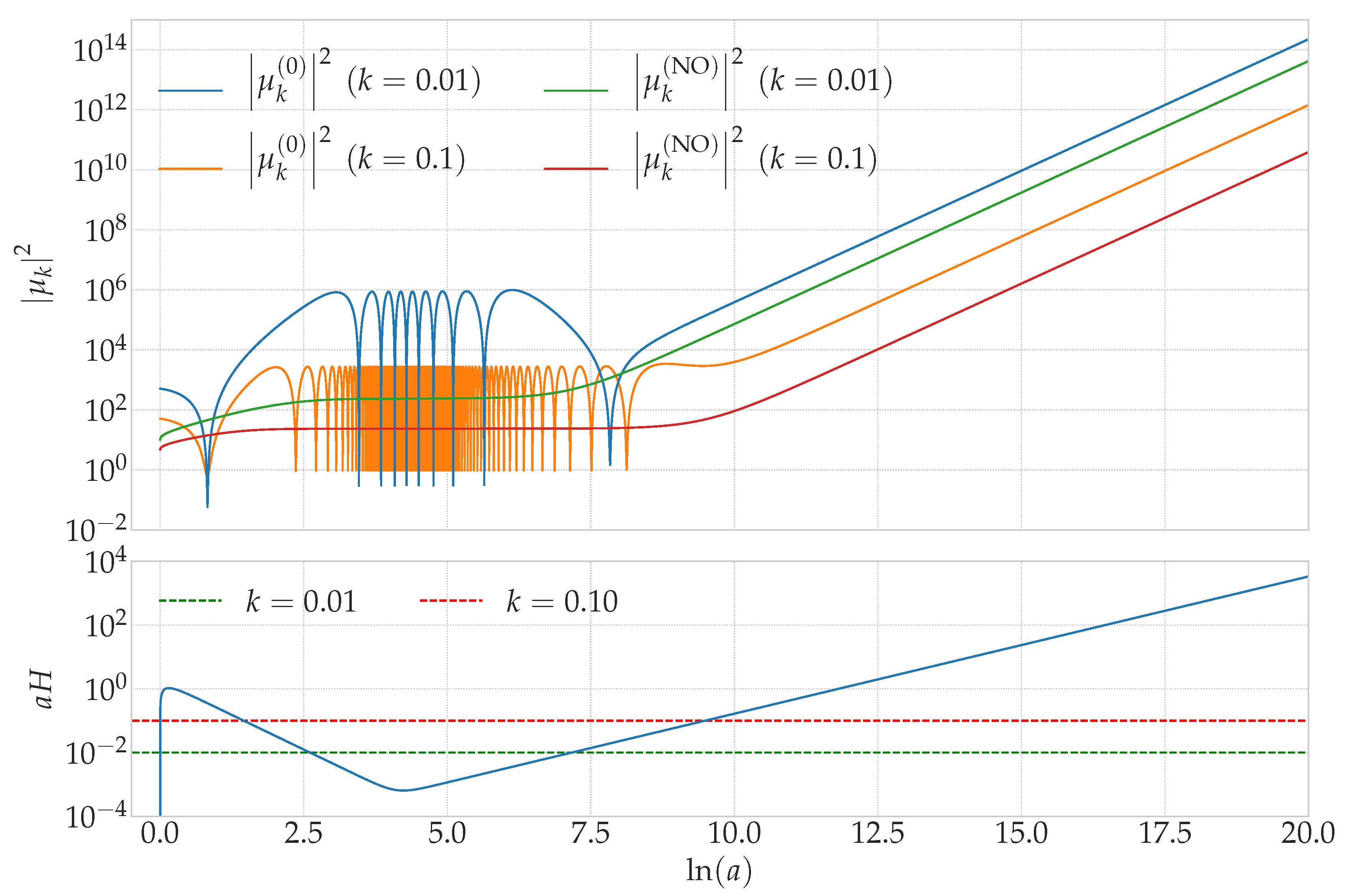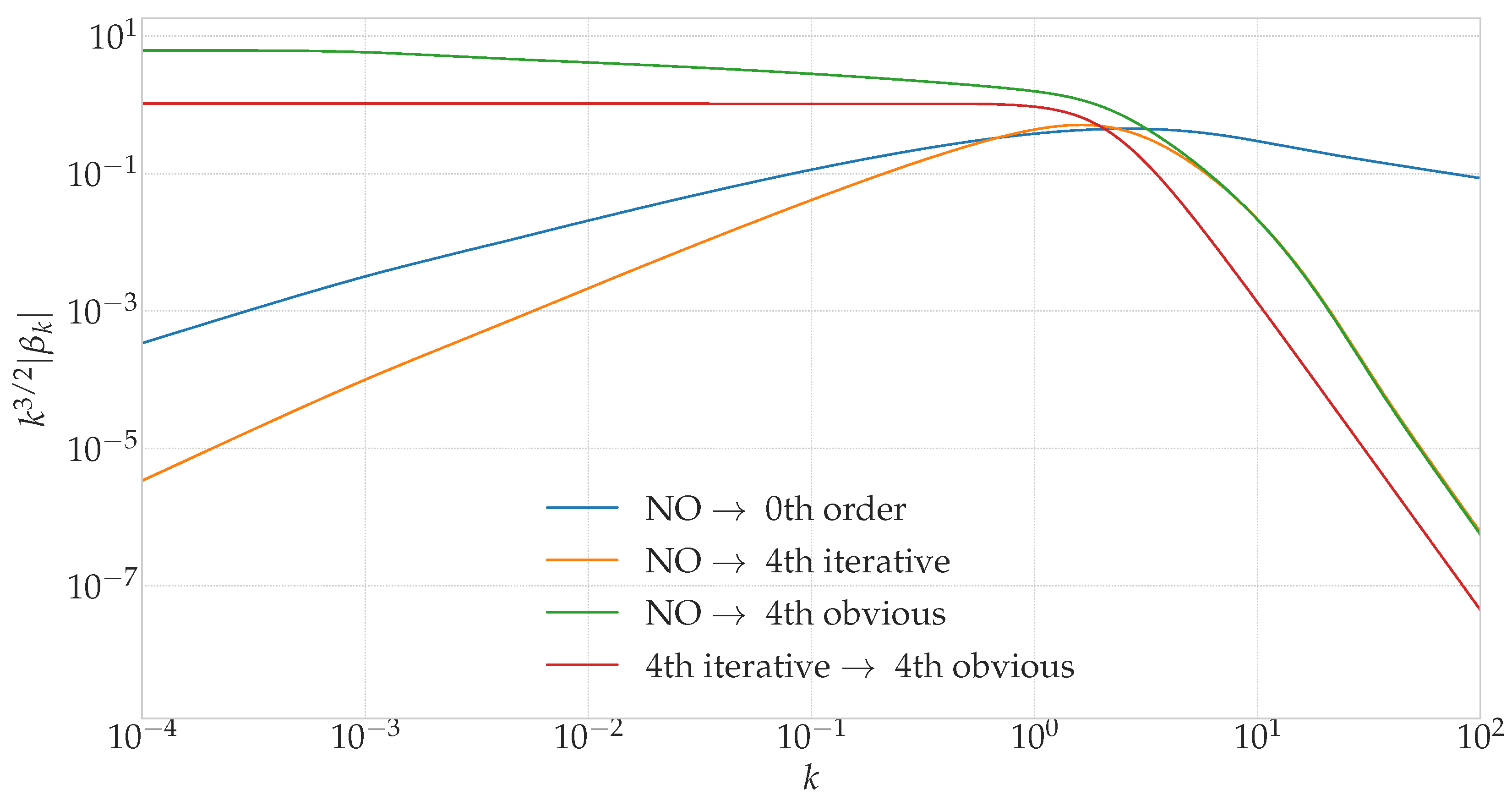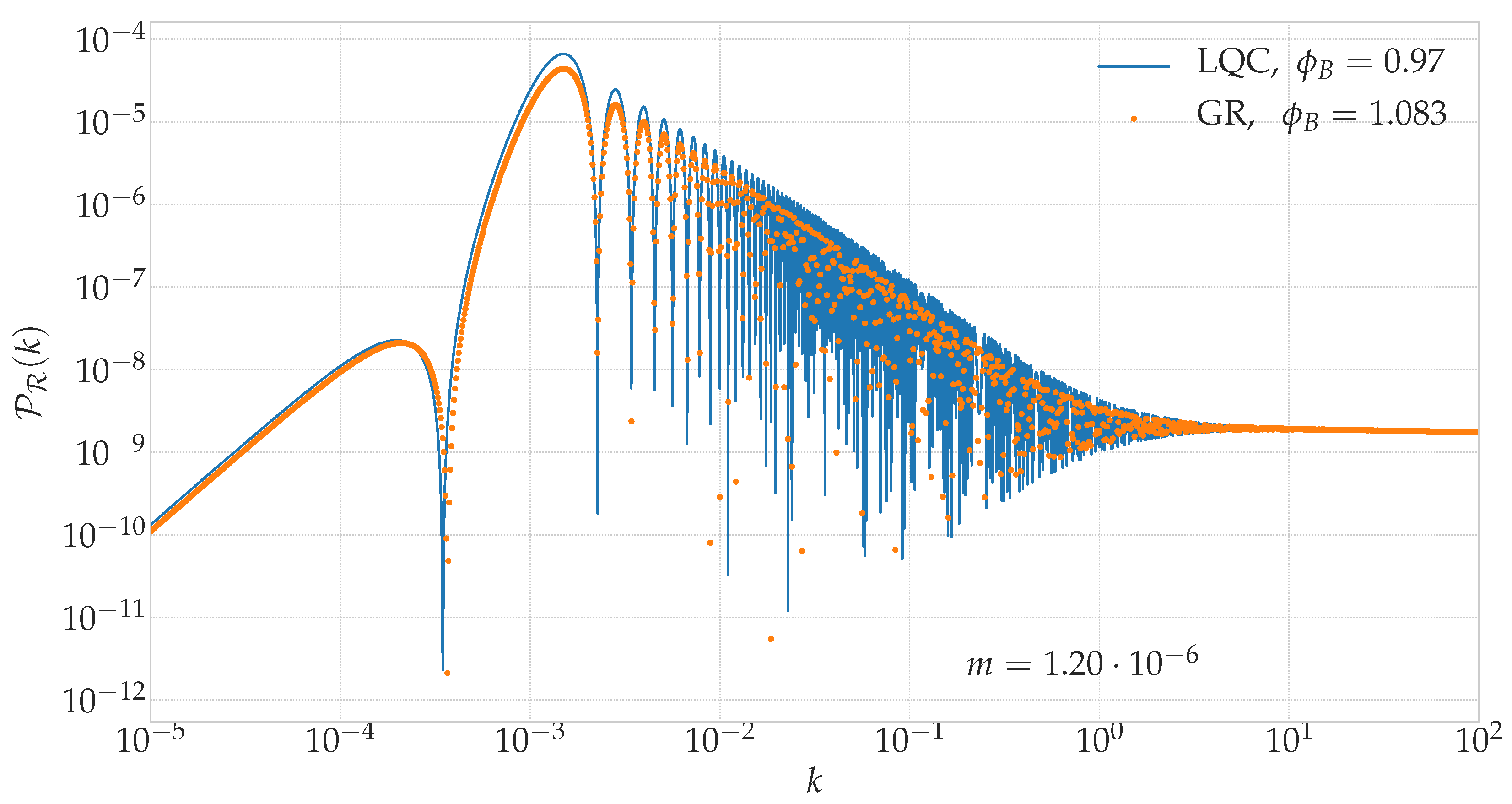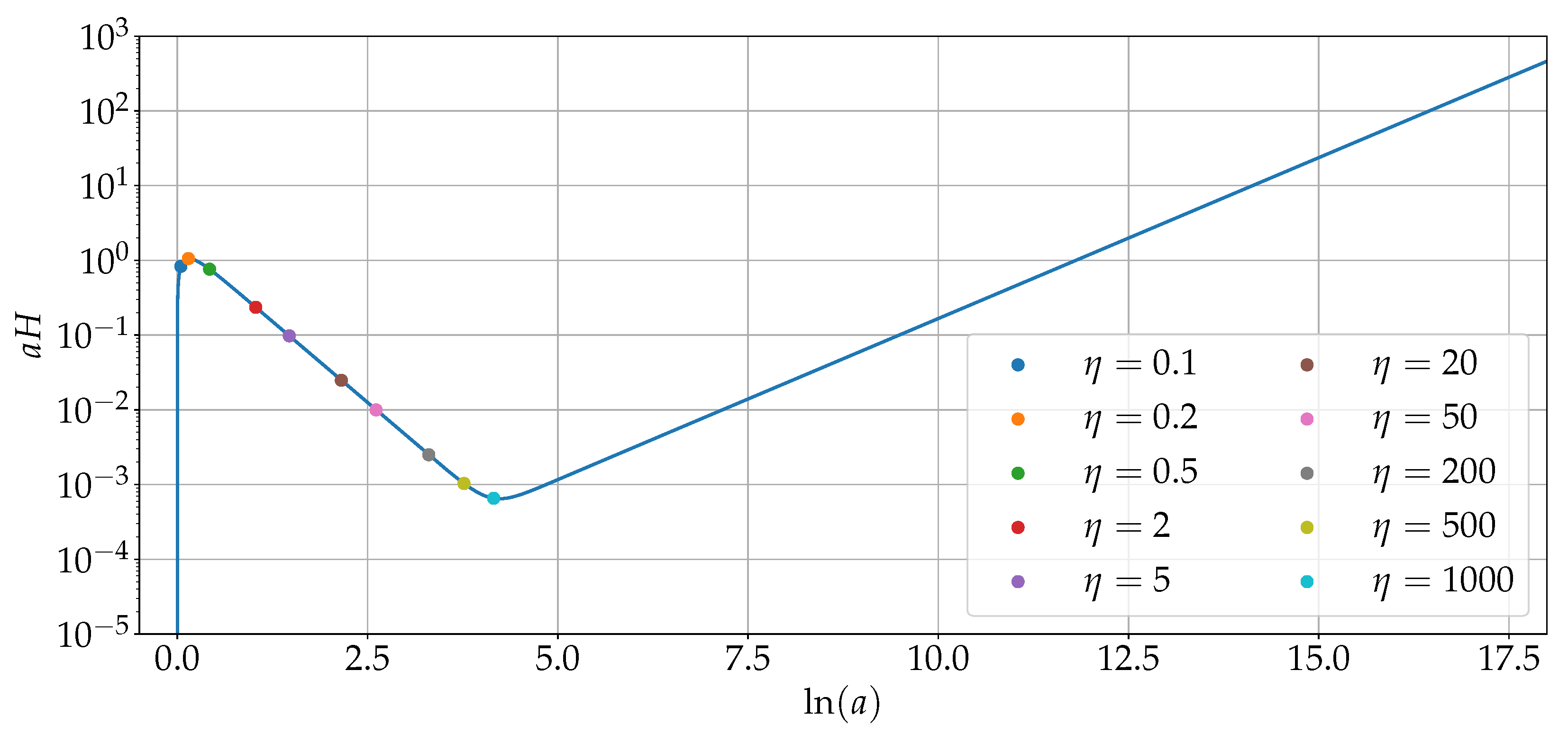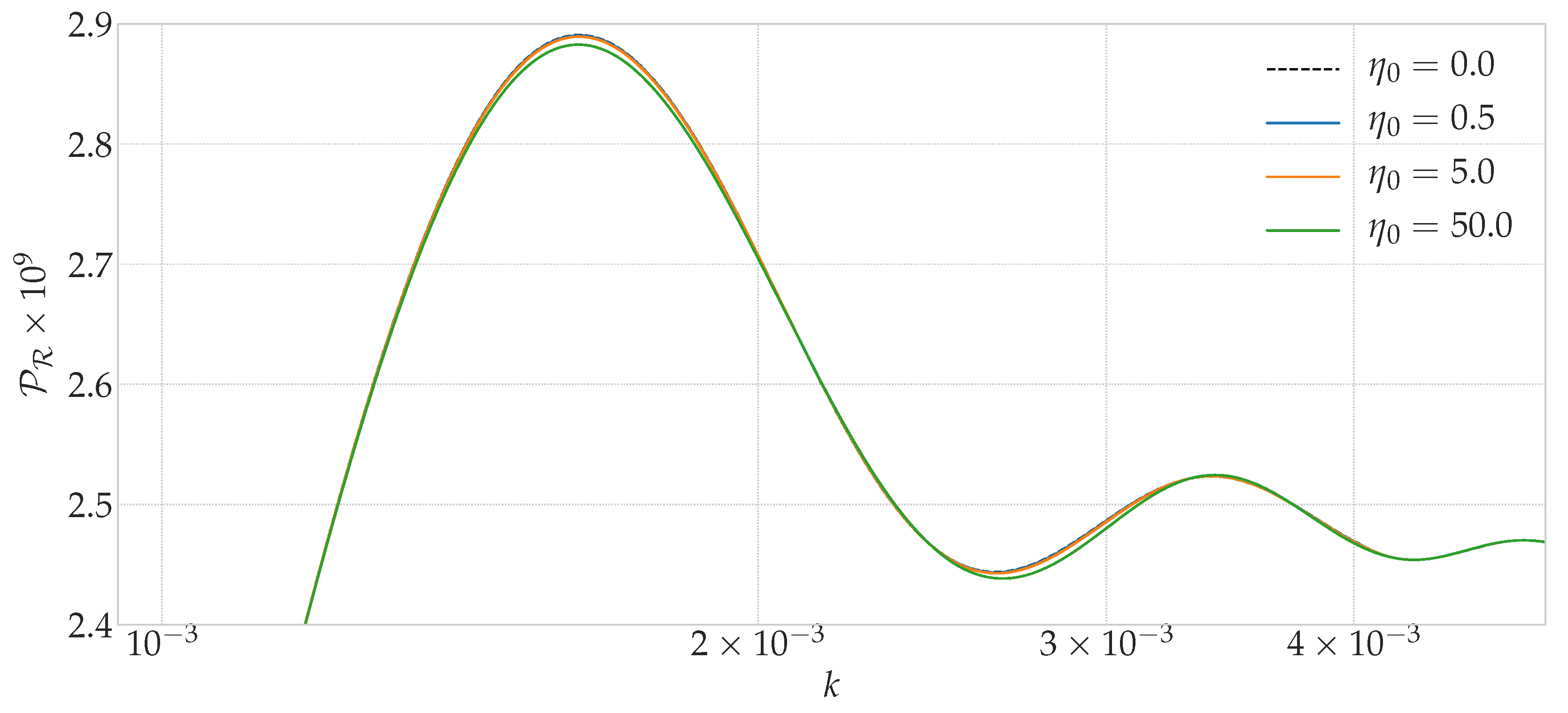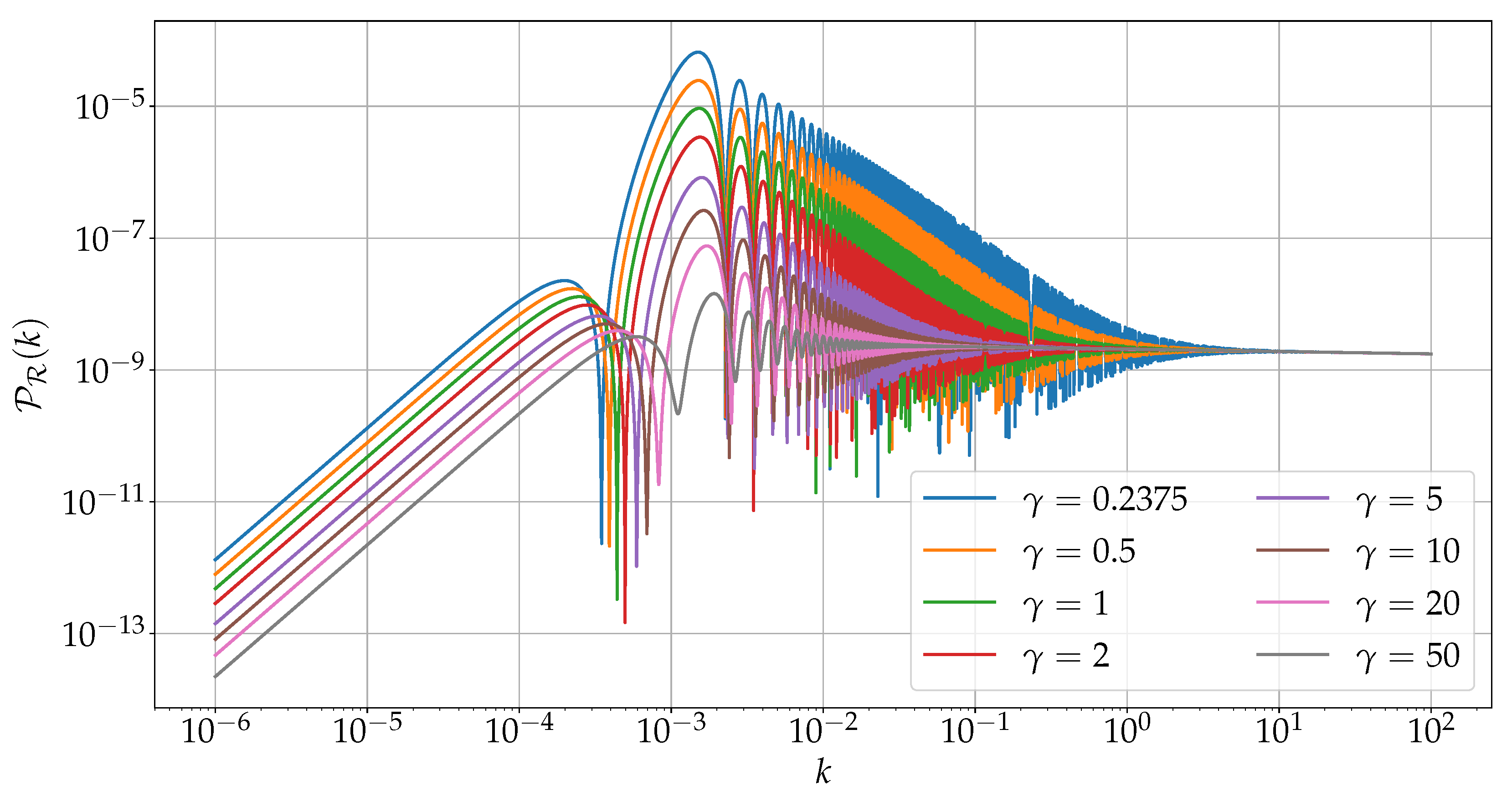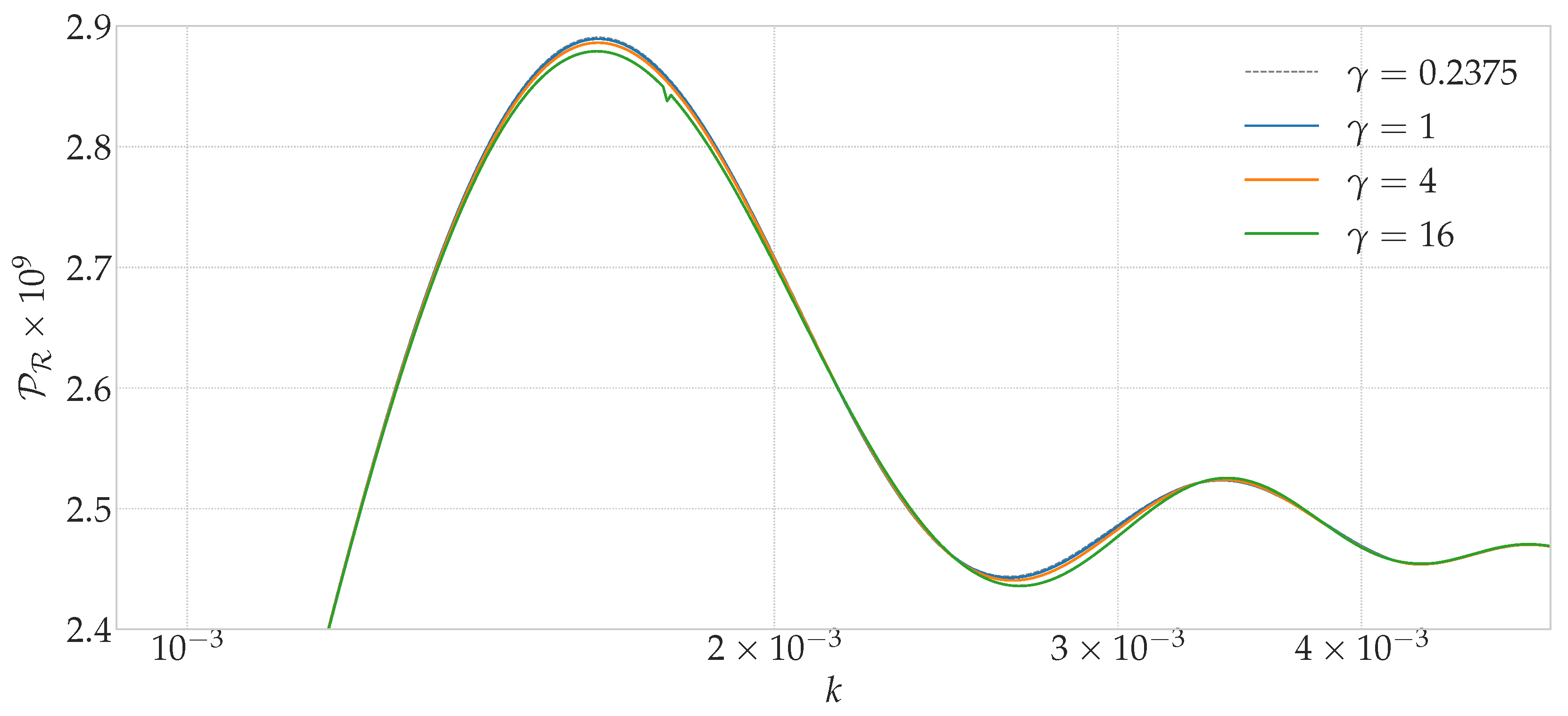1. Introduction
We have entered an era of increasingly accurate observations for a variety of phenomena that have cosmological origins or are influenced by strong gravitational fields, such as the power spectra of the Cosmic Microwave Background (CMB) [
1,
2,
3,
4,
5] or the emission of gravitational waves during the coallescence of black hole mergers [
6,
7]. These data allow us to try and falsify alternative theories of gravity that may modify the predictions of General Relativity (GR). Among these modifications, those that are due to quantum effects are especially interesting, because they open new avenues to learn about the consequences of the quantization of the spacetime geometry and elucidate which candidates are viable for a quantum theory of gravity. One of the most solid candidates is Loop Quantum Gravity (LQG) [
8], a non-perturbative canonical quantization of GR that is background independent. In LQG, the variables that encode the geometric information, rather than being constructed directly from the metric induced on the spatial sections and its extrinsic curvature, as in geometrodynamics [
9,
10], are holonomies along loops and fluxes through surfaces, defined in terms of the Ashtekar-Barbero
connection and a densitized spatial triad canonically conjugate to it [
8].
The application of the quantization techniques of LQG to cosmological systems is known as Loop Quantum Cosmology (LQC) [
11,
12]. LQC has got a notable success in homogeneous and isotropic models of the Friedmann-Lemaître-Robertson-Walker (FLRW) type [
11,
13,
14,
15]. In particular, LQC predicts that the big bang singularity is avoided by means of repulsive quantum geometry effects [
14,
15]. Moreover, there exists an ample family of quantum states in LQC with a highly semiclassical behavior at large volumes such that they remain peaked during all their history [
11,
16]. The peak determines an effective trajectory with remarkable properties [
11,
14]. For instance, for flat spatial topology, it coincides with the GR trajectory except when the matter density becomes considerably large, of the order of, let us say, a few thousandths of the Planck density. In that region of large densities, the trajectory still follows a Hamiltonian dynamics [
11,
14,
17], but this dynamics departs from GR and is generated by an effective Hamiltonian that includes quantum geometry corrections. In agreement with our previous comments, the trajectory is never singular, with the Einsteinian Big Bang replaced with a minimum in the volume that is strictly positive, and that is called the Big Bounce [
14]. This bounce occurs when a maximum matter density
, named the critical density, is reached [
11,
14].
To analyze more realistic situations in cosmology, homogeneous and isotropic LQC has been extended to include small anisotropies and inohomogeneities, treated as perturbations. This has been done adopting different approaches [
18,
19,
20,
21,
22]. Two of these approaches do not modify the dispersion relations of the perturbations, providing in particular a proper ultraviolet behavior that is compatible with the observed power spectra. These are the hybrid [
20,
23,
24,
25,
26,
27,
28,
29,
30,
31] and dressed metric approaches [
21,
32,
33,
34,
35,
36,
37]. Although there are plenty of similarities between these two approaches, the main distinctions follow from a slightly different strategy for the quantization of the perturbations [
38]. While the hybrid approach follows a canonical quantization of the whole system formed by the homogeneous geometry and its perturbations, subject to the constraints inherited from GR, the dressed metric approach incorporates the most important quantum effects on the homogeneous background in a dressed geometry and describes the evolution of the perturbations as test fields propagating in this dressed background. In the regime of effective LQC for the homogeneous geometry, and ignoring any backreaction, the two strategies that we have explained result in different time-dependent masses for the equations of motion of the perturbations, when these are written in a harmonic-oscillator form [
38]. The discrepancies between the masses occur, precisely, in the region where the quantum effects are relevant and the effective background differs from an Einsteinian solution.
Using the effective dynamical equations of the background and the modified equations of motion obtained in LQC for the cosmological perturbations, that are valid in the pre-inflationary epoch as well as during inflation, one can compute the cosmological power spectra [
29,
30,
33,
34,
36]. To do so, some important pieces of information are still missing: the initial conditions. The conditions for the homogeneous geometry are usually fixed by requiring a good phenomenological fit with the most recent observations. We will comment further on this issue later in our discussion. The situation with respect to the initial data for the perturbations, on the other hand, is more intrincate. Actually, these data determine the initial vacuum state of the perturbations. Obviously, the power spectra depend on this state. The fact that the history of the Universe is extended to the preinflationary era in LQC does not only alter the natural choice of this vacuum adopted in standard inflation, but also has consequences in the evolution of the quantum fluctuations, since no vacuum state is known that remains invariant under the resulting dynamics. These effects change the power spectra with respect to GR and add new features to them. The resulting predictions can be contrasted with the available observations of the CMB [
30,
33,
34] in order to support or reject the proposed approach to inhomogeneous LQC, combined with the specific choice of vacuum selected for the primordial perturbations.
In this work, we will focus our attention on the hybrid approach to LQC, although most of our comments and results can be generalized without much complication to the case of the dressed metric approach. A fundamental hypothesis in the hybrid approach [
39,
40,
41,
42,
43], shared by the dressed metric formalism in its basic guidelines, is that the most relevant quantum geometry effects are those that affect the homogeneous geometry, which is therefore analyzed using the characteristic polymeric quantization of LQC, whereas the cosmological perturbations can be described using a more standard, Fock quantization. During the last years, certain criteria have been put forward in the context of hybrid LQC for the unique selection of a family of unitarily equivalent Fock representations for the perturbations [
44,
45]. These criteria consist, basically, in the requirement of vacuum invariance under the spatial isometries of the (FLRW) background geometry and in the existence of a dynamical evolution for the associated creation and annihilation-like variables that can be implemented unitarily [
46,
47,
48,
49,
50,
51,
52]. Even if these criteria have proven to single out the representation up to unitary equivalence, the choice of a specific vacuum state in the Fock space of this representation is still open. Actually, in the cases studied so far, the Fock representation selected in this way turns out to contain physically appealing candidates for a vacuum such as adiabatic and Hadamard states (see e.g., Ref. [
50]). On the other hand, this choice of vacuum can be further restricted by imposing additional mathematical or physical requirements, for instance a well-defined quantum Hamiltonian or a regularizable backreaction [
53]. The determination of this vacuum is of the greatest importance from a conceptual point of view, with implications for all kind of systems that evolve away from stationarity. In addition, as we have pointed out, its fixation is essential to obtain definite results about the spectra of the cosmological perturbations, and hence to produce predictions that eventually could be confronted with the observations.
The rest of the paper is organized as follows. We first review the treatment of cosmological perturbations in hybrid LQC in
Section 2. In
Section 3 we summarize the criteria used in hybrid LQC to pick out a unique family of unitarily equivalent Fock representations for the quantum fields, and an associated Heisenberg dynamics that is unitarily implementable. Besides, we comment on the freedom available in this family and how to restrict it by demanding extra conditions on the Fock quantization. In
Section 4 we comment on the dynamical system obtained for the homogeneous geometry and the cosmological perturbations in hybrid LQC, the specification of initial data for them and, in particular, several proposals that have appeared in the literature to fix the data of the perturbations corresponding to a vacuum. We further discuss the choice of initial conditions and model parameters for the FLRW background within effective LQC in
Section 5, where we also analyze the typical behavior of the most interesting background solutions.
Section 6 deals with the computation of the power spectra for several possible choices of initial vacua and the comparison between them, setting the bounce as initial time. In
Section 7 we investigate which effects on the spectra are genuine quantum geometry modifications. We also consider changes in the initial time where the vacuum state is fixed. A similar study is carried out in
Section 8, but in this case varying a parameter of the model that arises from LQG, namely the Immirzi parameter [
54]. Finally, we conclude in
Section 9. Throughout the paper, we set the speed of light and the Planck constant equal to the unit,
.
5. Background Solution and Effects on the Perturbations
In this section, we will analyze the main characteristics of the effective solution for the homogeneous sector. We recall that we are interested in solutions that lead to power spectra compatible with the observations, but still retaining some quantum effects in the region of large scales. This determines a relatively narrow range of values for the initial condition on the inflaton, and for the value of the mass parameter. For concreteness, we will consider a specific solution in this set, namely, that corresponding to and (in Planck units). The properties of other solutions in our sector of interest are qualitatively similar.
The solution for our choice of
m and
is displayed in
Figure 1. We see that the rescaled Hubble parameter
, that separates the regions of wavenumbers that are inside and outside the Hubble radius, starts at zero at the bounce, grows rapidly in a period of superinflation where the scale factor is almost constant, and then decreases to a minimum. At the bounce, the solution is totally dominated by the kinetic energy of the inflaton, while the contribution of the potential is almost negligible. The kinetic energy density then decreases rapidly, approximately as
, as it would correspond to the case with vanishing potential, where the inflaton momentum is conserved and the density evolves as the inverse square of the physical volume. The decrease in the kinetic energy density continues until it becomes of the order of the potential, approximately at the time when
reaches its minimum, since
increases when the potential drives the evolution of the scale factor, as can be seen in Equation (
7). We note that, during the evolution from the bounce to the minimum of
, the inflaton increases, but only by a small factor of the order of 3. Therefore, the potential changes by one order of magnitude, approximately, during this period.
We recall that the energy density at the bounce is equal to , which is of the order of the Planck density. The energy density when the kinetic contribution becomes comparable to the potential, moment that approximately marks the minimum of according to our previous comments, can be estimated as follows. First, notice that the potential at the bounce is , which is of the order of in Planck units. Then, it suffices to take into account that, during the phase of decrease of the kinetic energy, the potential grows at most in one order of magnitude. This gives us a potential in the range . In the case of other effective background solutions in the sector of physical interest, for which may be slightly different and its increase in the kinetically dominated regime may be a little bigger, we can safely extend the considerations to the interval of energy densities at the coincidence between the kinetic and the potential contributions. The two densities and play a fundamental role in the phenomena experienced by the perturbations and, in a certain approximate sense, determine the regions where one can find effects that depart from the standard predictions of GR.
Taking into account Equation (
7) and the fact that the scale factor does not vary much during superinflation, it is not difficult to convince oneself that the maximum of
close to the bounce is of the order of the Planck unit with our convention of scales. On the other hand, soon after this superinflationary period, the energy density will have decreased sufficiently as to discard any quantum effect in the system, that will get adapted in this way to the GR dynamics. This implies that, from that moment on,
starts to decrease as
, and hence as the inverse square volume, according to our previous comments. Therefore
decreases as the inverse square of the scale factor. Recalling that the energy density decreases (as
) during this period by
orders of magnitude, we conclude that
(that goes as
) decreases to
. From all these considerations, it follows that the modes with wavenumbers (a bit) larger than one (in Planck units) do not cross the horizon during these stages previous to inflation, while modes with
exit and enter the horizon after the bounce and before inflation. Let us also comment that these modes would be the first to cross the horizon in any later epoch of inflation, therefore noticing any effect that could be attributed to an early stage of the inflationary process. Finally, modes with
are not inside the Hubble radius in the immediate vicinity of the bounce and do not reenter the horizon in the studied period.
After the potential has become equal to the kinetic energy density, the former starts to dominate while the latter continues to decrease. The scenario is that of a potential that remains essentially constant and drives an epoch of inflationary expansion. From the lower plot in
Figure 1 we can see that this period lasts approximately 60–70 e-folds, sufficient to be compatible with the observational bounds [
71]. Nonetheless, the number of e-folds already suggests an scenario of short-lived inflation. Hence, during the first moments of the inflationary process, the fact that the system is evolving from a kinetically dominated era can lead to departures from a slow-roll behavior. This will have consequences in the power spectra if the modes that crossed the horizon in those instants are observed today (see e.g., the discussion of Ref. [
72] in the context of GR). In particular, the slow-roll approximation will not be good, at least for modes that exited the horizon during those first stages of inflation.
We close this section by mentioning that, noticing that the potential is practically negligible around the bounce in the kind of background solutions of interest in LQC, the behavior of these solutions has been characterized by approximate analytic expressions in Refs. [
73,
74,
75], where different potentials have been considered, including the case of a mass contribution. In particular, these analytic expressions are useful to derive general properties of the solutions.
6. Power Spectra for Different Vacua
We will now analyze the primordial power spectra of the perturbations around the background described in the previous section, using the initial conditions at the bounce that correspond to different choices of vacuum state. We will consider the case of the scalar power spectrum. The results for the tensor perturbations are similar, and can be found in Ref. [
30].
In
Figure 2 and
Figure 3 we show the scalar power spectra for the lowest order adiabatic vacuum states. The results are compared with the spectrum obtained in the slow-roll approximation with the analytic estimation made by the Planck collaboration, given in Equation (
26).
A look at the power spectrum of the 0th-order adiabatic state in
Figure 2 reveals the existence of three regions. First, in the region of wavenumbers
k sufficiently greater than one, let us say
, the power spectrum is constant and coincides with the slow-roll prediction. Second, in an intermediate region with
, the spectrum presents rapid oscillations, that grow in amplitude as
k decreases. Third, and finally, for
the power is suppressed. Notice that there is a clear relation between these three regions and those identified in the previous section according to the behavior of the rescaled Hubble parameter
on the background solution. This relation lies at the root of the phenomena observed in the power spectrum.
The spectra of
Figure 3 show similar results, also with three regions, but we see that the quantitative result depends strongly on the specific vacuum state under consideration. In particular, the suppression of power at large scales is present for all iterative adiabatic states, but not for some of the obvious ones, indicating that the predictions for this latter type of states are less robust against a change in the iterative order. Despite these discrepancies, we emphasize that the regions with different behaviors are the same in all cases.
The power spectrum for the NO-vacuum is displayed in
Figure 4, comparing it with the corresponding spectra of the 0th-order adiabatic state and the slow-roll approximation. In this case, we find a remarkable coincidence with the slow-roll spectrum in a much wider range of modes, with a total absence of rapid oscillations. The region of small wavenumbers still presents a suppression of power. Finally, we also notice some minor features in the spectrum, in the matching region with the predictions of the slow-roll approximation.
The computation of the angular spectrum of temperature anisotropies in the CMB can be computed using e.g., the CLASS code [
76]. We have carried out this integration using the best-fit values of the parameters of the base
CDM model provided by the Planck Collaboration in Ref. [
3] (using the so-called TT+lowP data). The integration has been performed allowing for lensing corrections in the code, in order to improve the accuracy of the results. An additional issue that must be faced before comparing the predictions with the observations is a change in the scale that we have used so far in our calculations of the primordial spectra. This scale was fixed by setting the physical volume at the bounce equal to one. Nevertheless, the observational data usually employ the present value of the physical volume as the unit of reference. This requires a scale matching between the two situations. The matching is made by identifying the scale of reference that the Planck mission uses for
k, namely the pivot scale
, with the value of
k that has the same amplitude observed for
[
3]. The matching is made in the set of modes that crossed the horizon in slow-roll regime, because the spectrum turns out to be monotonous for
k in that set, a fact that guarantees that the solution is unique [
30].
The resulting angular spectrum of temperature anisotropies for the NO-vacuum state at the bounce is displayed in
Figure 5. The figure shows the spectrum obtained on the solution studied in
Section 5, but also on other effective background solutions with the same value of the inflaton mass, but slightly different initial data for the inflaton at the bounce. The best fit of the observational data obtained by the Planck Collaboration is displayed as well for comparison. In particular, we notice that the suppression of power and the features that are present in the spectrum of the NO-vacuum may provide an explanation for the lack of power and the possible anomalies that the records of Planck seem to indicate at large and intermediate scales [
3].
To help visualizing the origin of these phenomena and make more evident the different behavior of the modes in the distinct vacua, we show in
Figure 6 the evolution of two of the modes that exit and enter the horizon in the period between the Big Bounce and the beginning of inflation. We take initial conditions at the bounce that correspond either to the 0th-order adiabatic state or to the NO-vacuum, for comparison. We clearly see a region of rapid oscillations and amplification of the power of the modes in the adiabatic state. This region is related with the period when the modes are inside the horizon, after reentering it in the post-bounce evolution and before they exit again in the early stages of the inflationary process. In the NO-vacuum, on the other hand, the modes do not display these rapid oscillations, but remain almost constant in that region.
Finally,
Figure 7 shows the beta coefficients for the Bogoliubov transformation between different adiabatic states and the NO-vacuum, as well as between two vacua of 4th order. We consider the two types of adiabatic states introduced in
Section 4, i.e., obvious and iterative adiabatic vacua. According to Equation (
25), the behavior of the beta coefficient at large
k seems to indicate that the NO-vacuum behaves asymptotically as an adiabatic state of high order, at least equal to 4.
7. Choice of Initial Time and Effect on the Power Spectra
We have seen that, in general for adiabatic states and always for the iterative ones, one gets a primordial power spectrum that presents a region with rapid oscillations, with the corresponding enhancement of power in comparison with the slow-roll spectrum when these oscillations are averaged. Although one might believe that these rapid oscillations are due to the quantum corrections generated by LQC, a close inspection to the modes that are affected makes us suspect that the oscillations may rather appear because these modes cross the horizon immediately after a period in which the kinetic energy density of the inflaton is important in the background solution. The exposition of the fluctuations to a period of kinetic dominance can have relevant effects in the spectrum [
72]. In particular, this may put into question the choice of adiabatic sates (at least the lowest order ones) as natural vacua for the perturbations.
To understand this issue, we can investigate whether similar oscillations would appear in the primordial spectrum of adiabatic states if we consider background solutions like those in effective LQC, but now in GR. We can try and find solutions in GR that have the same behavior as the original effective ones in the region of large volumes, and continue them back to the regions of high density that correspond to the bounce and its vicinity in LQC. In this way, the GR solutions will coincide with the effective solutions at late times, but not around the initial time, identified with the bounce of the LQC trajectories. In
Figure 8 we compare the primordial spectrum of the 0th-order adiabatic state in hybrid LQC on the effective solution considered in
Section 5, with the primordial spectrum of the same state in GR, and on the background constructed also in GR as we have explained above. In this GR solution (obtained with the same value of the mass), the value of the inflaton at the time that would correspond to the bounce in LQC is
. We see that the two spectra are similar, with the same kind of oscillations. Furthermore, these oscillations possess similar amplitudes. In this sense, the most relevant departures from the standard inflationary models that are observed in this adiabatic spectrum are not genuinely due to quantum geometry effects, but rather to other phenomena that can be rooted in a kinetically dominated phase previous to the onset of inflation. Obviously, the spectra of hybrid LQC contain also quantum modifications, but in cases like the low-order adiabatic states at the bounce (or in its vicinity), these modifications of the spectra are hidden by others that are related to non-conventional preinflationary and inflationary stages, stages that turn the question of a natural choice of vacuum into an open issue. To analyze in depth the quantum modifications of the spectra, and confront the predictions about them with observations, it is necessary to reach a better characterization of such modifications and disentangle them from the rest of corrections.
An important distinction between the possible oscillations in GR and those in LQC is that the latter are confined to a sector of energy densities that is bounded from above by the critical density , whereas no such a bound exists in the Einsteinian theory.
An alternative way to investigate whether the rapid oscillations are an effect of the LQC corrections or are due to other reasons is the following. Until now, we have considered the bounce as a natural choice of time in order to set initial conditions on the state of the perturbations. The final form of this state that determines the primordial power spectrum depends on the evolution of the background solution from the bounce to the end of inflation, and on the specific time-dependent mass that enters the propagation equations. This mass has the same expression as in GR except for corrections that are relevant only in the same region where the effective background solution in LQC differs from its counterpart in GR. In total, we see that all possible quantum corrections, either in the expression of the time-dependent mass or directly in the background solution, are confined to the region with high energy density of the inflaton (let us say greater than ) that surrounds the bounce. As soon as we get away from the bounce, these quantum effects disappear. Therefore, a procedure to check if certain phenomenon is produced by these effects is to move the initial time away from the bounce, and closer to the onset of inflation.
In
Figure 9 we show a set of alternative choices of time in the interval between the bounce and the onset of inflation, displaying the value that the rescaled Hubble parameter
reaches at that time in the background solution. We then plot in
Figure 10 the primordial power spectrum obtained by taking initial conditions at those times, corresponding to the respective 0th-order adiabatic vacuum state in hybrid LQC on the background solution analyzed in
Section 5. It is clear that the rapid oscillations are removed as the initial time gets closer to the onset of inflation. This is consistent with the statement that these oscillations are not a genuine product of the quantum geometry, but rather of the epoch of kinetic dominance and of its effects on the evolution of the perturbations.
8. Dependence on Parameters
Our definition of the NO-vacuum state depends on the choice of a time interval in which the oscillations in the power of the vacuum solution are minimized, mode by mode. Until now, we have chosen the Big Bounce as initial time for this interval, and the final time has been identified with the moment in which the kinetic energy of the inflation vanishes for the first time, something that happens when the inflationary expansion has already started. Numerical analyses show that the results do not depend heavily on our particular choice of final time if the changes are small. These changes generically affect the features that are present in the spectra at intermediate scales, for wavenumbers k in the region that separates the sector with suppression of power from the sector where the slow-roll approximation applies. As the changes in the final time increase, letting it approach the bounce, the power spectra start to display oscillations, with the subsequent enhancement of power on average. The closer gets to the region with quantum geometry effects, the larger the increase of power.
On the other hand, the changes of initial time do not seem to have an important impact in the spectra, at least if
remains well inside the kinetically dominated region. In
Figure 11, we show the changes in the primordial power spectrum for the NO-vacuum on the background solution of
Section 5 when the initial time
is varied. We see that the changes are small. We only display the interval
because the changes are tiny outside this interval.
A different dependence of our results is on the parameters of the LQC quantization. There are two of these parameters, namely the Immirzi parameter
and the area gap
. In our discussion so far, we have taken the standard values that are adopted for these parameters in LQC, based on arguments about black hole entropy and the spectrum of the area operator, respectively. We recall that these values are
and
. The two parameters affect the value of the critical density, which varies with them as
. Hence, when the Immirzi parameter increases, or when the area gap increases (keeping
G constant), the critical density decreases. This decrease makes the critical density approach the energy density where inflation begins (if the decrease is not radically large), reducing the region of kinetic dominance and placing the initial time where the vacuum is chosen closer to the inflationary period. Notice that if the decrease in the critical density were even larger, we would enter a completely different scenario where the bounce would be followed directly by a period of standard (potentially dominated) expansion. It would be interesting to study the modifications to the power spectra in this alternative scenario. On the other hand, let us point out that a change of the Immirzi parameter involves a rescaling of the physical volume, according to Equation (
2). This rescaling changes the effective background solution. The new solution can be found with a matching process, integrating the effective trajectory for the new value of
backwards from a matching time that is sufficiently far away from the bounce, using there the rescaled value of the physical volume. This matching guarantees that the original and the new solutions share the same behavior for large volumes, since in that region the GR equations, that are independent of
, are valid.
The primordial scalar power spectrum of the 0th-order adiabatic vacuum is displayed in
Figure 12 for different values of the Immirzi parameter, including the standard value 0.2375. These spectra confirm our expectations that the oscillations get damped as
increases. For the NO-vacuum, on the other hand, the primordial power spectrum is shown in
Figure 13. We plot only the interval
because, again, the changes turn out to be negligible for other values of
k. In contrast with the situation encountered for the 0th-order adiabatic state, the variations in the spectrum are now very small. The background solution used in the computation of these spectra is, once more, the effective solution analyzed in
Section 5.
9. Conclusions
We have discussed the role and determination of the vacuum state for quantum fields treated as perturbations in the framework of LQC. We have focused our attention on the hybrid approach to LQC, although most of our analysis can be extended to other proposals, like the dressed metric approach. For our discussion, we have considered an FLRW universe with compact flat topology in the presence of a massive scalar field, and we have perturbed it at quadratic order in the action. In this perturbative formalism, the zero modes that describe the FLRW cosmology have been treated exactly at the adopted order of truncation. On the other hand, the non-compact case can be included in the study by taking an appropriate limit [
61]. In our system, formed by the homogeneous FLRW cosmology and its perturbations, we have introduced a canonical transformation that respects the gauge invariance at the perturbative level of truncation. With this transformation, the system can be described by MS and tensor gauge invariants, linear perturbative constraints and their momenta, and zero modes. In a hybrid quantization, the physical states of this system depend only on the zero modes and on the perturbative gauge invariants. The sector of zero modes is quantized with the techniques of homogeneous LQC, while the perturbations are quantized with more standard, Fock methods, using a Fock representation in a family of unitarily equivalent choices, that is selected by criteria based on invariance under spatial symmetries and unitarity of the Heisenberg evolution in the selected family of creation and annihilation operators.
In this hybrid representation, the considered states are still subject to one constraint, provided by the zero mode of the total Hamiltonian. To search for solutions of physical interest, we have adopted an ansatz of separation of variables, in which the states factorize in a product of partial wavefunctions, one for the homogeneous geometry and one for each of the modes of the gauge invariant perturbations. All of these partial wavefunctions are allowed to depend on the inflaton (the zero mode of the scalar field), that plays the role of an internal time in the system. Assuming that the perturbations mediate no relevant transitions of the FLRW geometry through the action of the constraint, and taking expectation values of this constraint in order to extract the most important information, one obtains a master constraint that governs the evolution of the perturbations. In this way, one can derive dynamical equations for the gauge invariants, that can be written in a harmonic-oscillator form, with time-dependent masses that are supplied by (ratios of) expectation values of LQC operators in the quantum state that describes the FLRW geometry. We have then concentrated our attention on the case that this state is a(n approximate) solution of homogeneous LQC that remains peaked on a trajectory of the so-called effective dynamics. In this case, the time-dependent masses for the perturbations can be evaluated directly on these effective trajectories.
To integrate the evolution of the perturbations, as well as the effective dynamics of the homogeneous background, one needs to specify a set of initial conditions. These conditions are, e.g., the value of the inflaton at the Big Bounce for the background, and the initial value of the gauge invariant modes and of their time derivatives for the perturbations. In addition, the background evolution depends on the value of the inflaton mass, that we regard as a parameter. We have found a sector of values of this mass and of the inflaton at the bounce such that the background solution leads to an inflationary era that can be compatible with the observations of the CMB, but still allows for imprints of quantum effects in the spectra, especially at large scales. We have analyzed the behavior of these kind of solutions, focusing the discussion on a specific background, corresponding to the choices and in Planck units. In particular, we have seen that this solution presents a period of kinetic dominance, from the Big Bounce till the early stages of the inflationary process.
Using this background solution, it is possible to integrate the equations of motion for the perturbations until the end of inflation, and then get the primordial power spectra needed to run the Boltzmann codes that provide at last the angular spectra that can be compared with the observational data. To carry out this program, we still need a piece of information of major relevance: the initial state of the perturbations. Fixing these initial data amounts to choosing a vacuum state at the initial time for the quantum fields of the gauge invariants. In this manner, we arrive at the most important issue studied in this work: the crucial dependence of the power spectra on the choice of vacuum (at least at large scales) and possible ways to fix this state, based on physical criteria.
Adiabatic states may be useful in order to constraint the ultraviolet behavior and obtain good regularization properties, but there is still an infinite freedom in the choice of an adiabatic vacuum. In particular, we have considered two schemes to construct this type of states: obvious adiabatic states and iterative ones. In addition, in both schemes the state depends on the order of the asymptotic adiabatic approximation and on the initial time adopted for its construction. We have seen that the spectra of the iterative adiabatic states are most robust under changes of the adiabatic order than the obvious ones, and that they also provide a better behavior at the largest scales, with more suppression of power. Nonetheless, these states typically present a region with rapid oscillations in the spectrum and a consequent enhancement of power on average, something that seems to go against the behavior observed in the CMB.
1We have discussed in detail an alternative proposal for the vacuum state: the non-oscillatory vacuum introduced by Martín de Blas and Olmedo [
29]. The definition of the NO-vacuum state takes into account the dynamics of the perturbations in a time interval, and adjusts the vacuum to lead to a primordial power spectrum without large oscillations. We have seen that this vacuum provides a spectrum with a satisfactory suppression of power at large scales, like in the case of some adiabatic states, but in addition the resulting spectrum is now smooth and can fit very well the observations, making the proposal very appealing. In the case of the dressed metric, an apparently different vacuum that provides a spectrum with a good behavior and also fits the observations has been put forward by Ashtekar and Gupt [
68]. It would be interesting to compute the corresponding spectrum for this vacuum in hybrid LQC and compare the results with the NO-vacuum.
To investigate the reasons behind the rapid oscillations and the averaged increase of power observed for the adiabatic states, we have considered initial conditions of the adiabatic type at later times, closer to the onset of inflation, as well as adiabatic states evolving with the dynamical equation of GR (on a background that is the GR counterpart of the effective solution studied in
Section 5). Our results indicate that these effects should be attributed to the choice of adiabatic data at an initial time that belongs to a kinetically dominated phase of the evolution, rather than to genuine quantum effects produced by the quantization of the geometry. The same oscillations and increase of averaged power appear also in GR. Actually, LQC puts a bound on the amplitude of those oscillations, because the energy density can never exceed the critical value
in the LQC scenario.
In addition, we have analyzed the sensitivity of the NO-vacuum spectrum to a change of the time interval employed for the definition of this vacuum. We have seen that the spectrum remains almost identical if the initial and final times are not changed considerably. Important modifications appear only if the interval does not cover the kinetically dominated epoch or if the final time of the interval approaches the bounce.
Finally, we have investigated the dependence of the power spectra on the value of the Immirzi parameter, assuming the hypothetical case that this parameter might be varied. The higher the Immirzi parameter gets, the lower the difference becomes between the energy density at the bounce and at the onset of inflation. This reduces the period of kinetic dominance, damping the oscillations in the case of adiabatic states. For the NO-vacuum, on the other hand, the spectrum turns out to be quite stable under a change of the Immirzi parameter.
